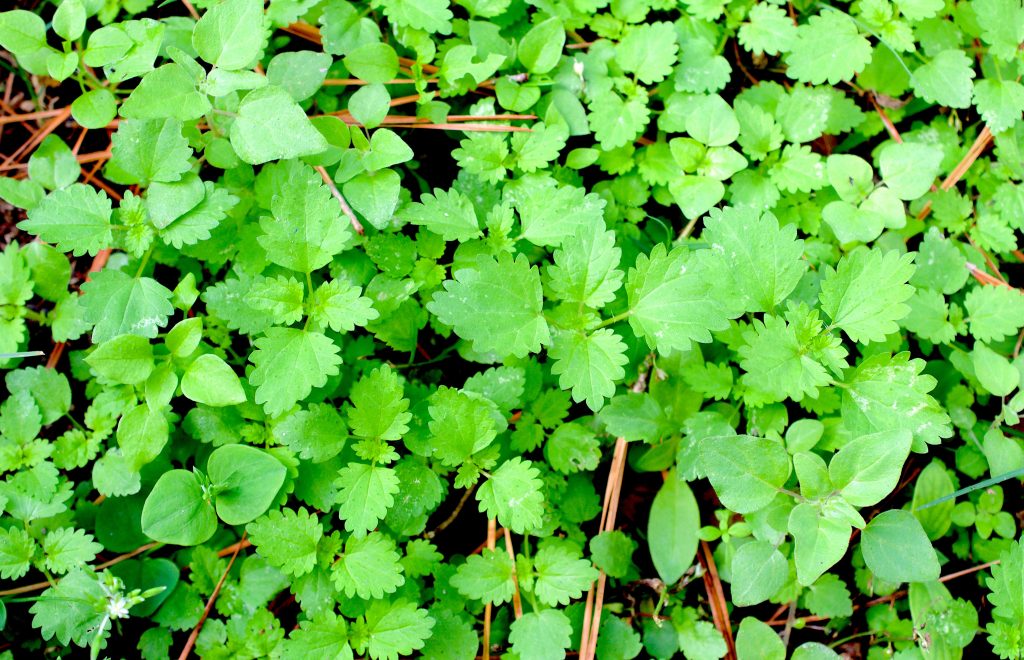
Reaching for Pellitory and finding Stinging Nettle is a rude surprise. Photo by Green Deane
Now’s the time for all good foragers to be wary: There is pain lurking in the weeds. During Sunday’s foraging class we saw a patch of light green on the darker lawn grass. It was a splotch of Pellitory. But as I kneeled down to examine it closer the danger announced itself: Stinging Nettle. Despite my precaution I still managed to get stung on one knee.
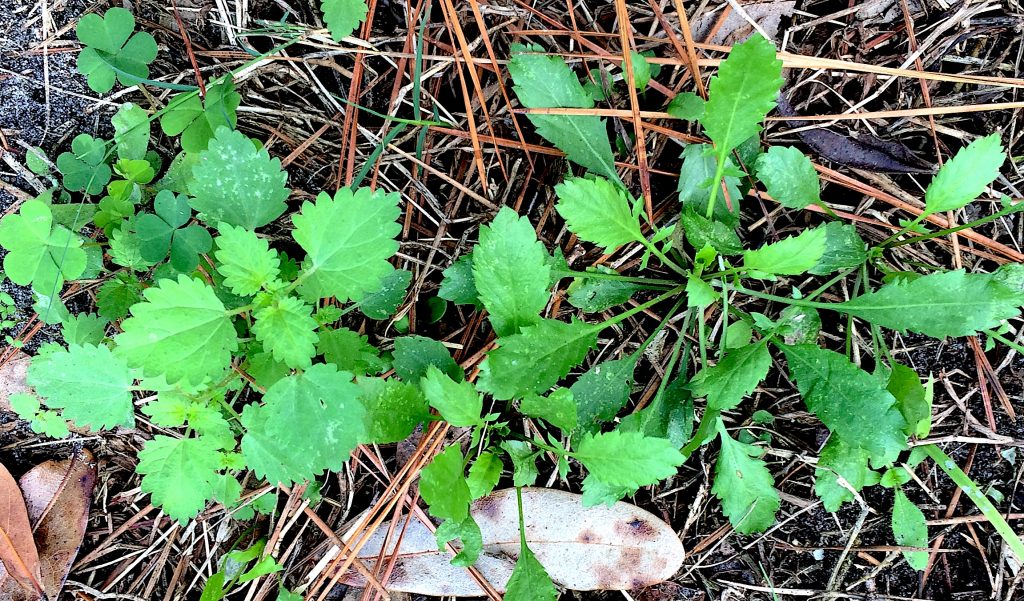
Oxalis, Stinging Nettles, Pepper Grass. Photo by Green Deane
This is no ordinary Stinging Nettle. Its botanical names means “Stinging Dwarf” and it might be the second-worst nettle sting on earth. There’s a nettle in New Zealand that kills animals and has caused at least one human death. Our nettle, Urtica chamaedryoides, aka Heartleaf Nettle, barely gets a foot high but it has a tremendous sting. While I can eat the nettle with no problem if I get stung I develop a welt that lasts for several day and stays intensely painful for several days. I liken the initial sting to like that from a foot-long wasp. It really hurts and none… n-o-n-e … of the so-called remedies do much to ease the pain. So be careful.
Least you think that is my imagination at work the University of Florida says the little burner is becoming a problem with humans and livestock. They call it “Fireweed.” “Fireweed is particularly troublesome because it possesses stinging hairs that easily embed in skin. Once exposed to the toxin, severe irritation can occur for several hours. Though generally avoided by cattle, horses are more likely to browse Fireweed and develop stress symptoms. These symptoms commonly manifest themselves as weight loss, or difficulty in swallowing and breathing for many days after consumption. In extreme cases, young horses have died after rolling in Fireweed and becoming over-exposed to the toxins in the leaf hairs. Fireweed leaves resemble that of a strawberry plant but the plant as a whole has little resemblance to strawberry. The plant has square stems and small pale green flower clusters. Small stinging hairs are found on the stems, petioles, and leaves. These hairs contain irritants that have been shown to cause respiratory stress and local allergic reactions when ingested or inhaled.”
Fortunately the stingers are not below ground so you can pick the plant at its base, very carefully, or just wear gloves. My favorite way to eat them is to set them next to a fire and let them wilt to the point of almost being dehydrated. That neutralizes the sting and they resemble kale chips in flavor. To read more about the “Stinging Dwarf” go here.
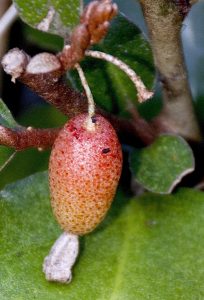
Silverthorn berries ripen in Feburary.
Valentines Day is a long ways off but now is the time to start finding you local stands of Silverthorn. Why Valentines Day? That around the time when the shrub has edible fruit. Silverthorn is an ornamental that was brought to the United States perhaps 200 years ago. For some reason botanists back then thought the birds would not be interested in the jelly-bean size fruit. They said the fruit were not nutritious for birds. No one, however, told the birds. The species is invasive and illegal in some states. What prompted this early mention of Silverthorn is in my foraging class this weekend we saw one in blossom (early I might add.) The off-white blossom looks like a rectangular box. The red fruit with silver and gold speckles is usually ripe around Valentine’s day which is about 10 weeks away. But if they are blossoming early they might be ready by the beginning of February. The little fruit is high in Vitamin C, Omega 3 fatty acids and the antioxidant lycopene. However they must be ripe or they will be very bitter. You can read more about the Silverthorn here.
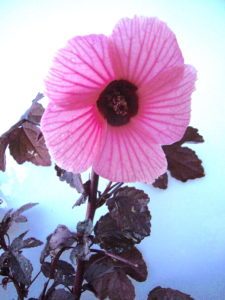
Red leaves and blossoms are edible.
Also blossoming now is the False Roselle. It’s not a misunderstood species but is often overshadowed by its relative the True Roselle. I noticed a False Roselle blossoming in my neighborhood this week. While it can bloom nearly any time it was particularly festive. What I like about the shrub is it’s nearly all edible. The leaves are tart and red. They are great in salads and hold their color and flavor when cooked. The blossoms are edible and the calyx can be coaxed into a false lemonade. But a bit of warning: It does not like cold weather. A light freeze can burn it back to ground level or kill it. So here’s what I do. When freezing weather is predicted I cut off several ends of the branches. I take off the lower leaves and stick the cut branches in water. Within 10 days they will be happily rooting and you’ll have plenty of starts for next season. Stick ‘em in a pot with a bit of good soil and they’ll be ready for planting when the winter weather breaks. To read more about the False Roselle go here.
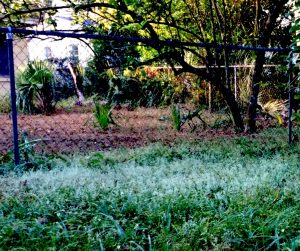
West Indian Chickweed can look like snow.
Drymaria cordata… Drymary… West Indian Chickweed… White Snow. Hopefully you can see in the accompanying picture why this species is called White Snow. When it is seeding and the sun hits the seed heads just right it can resemble a patch of white snow on your lawn. Unlike true chickweed, which is Stellaria media, Drymary is here most of the year but has similar uses to true chickweed (which we won’t see for another month or so.) Young leaves and shoots are edible, older leaves have some medicinal uses including use as a diuretic. There is some research that suggests it can reduce coughing and can easy anxiety. You can read more about Drymary here.
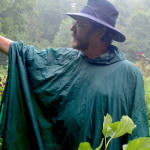
Classes are held rain or shine or heat or cold…
Foraging Classes: Traveling this weekend with classes in Sarasota and West Palm Beach.
Saturday, December 2nd, Red Bug Slough Preserve, 5200 Beneva Road, Sarasota, FL, 34233. 9 a.m.
Sunday, December 3rd, Dreher Park, 1200 Southern Blvd., West Palm Beach, 33405, 9 a.m. We meet just north of the science center.
Sunday, December 10th, Bayshore Live Oak Park, Bayshore Drive. Port Charlotte. Meet at the parking lot at the intersection of Bayshore Road and Ganyard Street. 9 a.m.
Saturday, December 16th, Blanchard Park, 10501 Jay Blanchard Trail, Orlando, FL 32817. 9 a.m. Meet by the tennis courts near the WMCA building.
To learn more about the classes go here.

Green Deane set of 135 DVD about foraging
All of Green Deane’s videos available for free on You Tube. They do have ads on them so every time you watch a Green Deane video I get a quarter of one cent. Four views, one cent. Not exactly a large money-maker but it helps pays for this newsletter. If you want to see the videos without ads and some in slightly better quality you can order the DVD set. It is nine DVDs with 15 videos on each for a total of 135 videos. Many people want their own copy of the videos or they have a slow service and its easier to order then to watch them on-line. The DVDs make a good gift for that forager you know especially on long, cold winter months. Individual DVDs can also be ordered or you can pick and choose. You can order them by clicking on the button on the top right hand side of this page (if your window is open wide enough.) Or you can go here.

Green Deane Forum
Want to identify a plant? Looking for a foraging reference? Do you have a UFO, an Unidentified Flowering Object you want identified? On the Green Deane Forum we chat about foraging all year. And it’s not just about warm-weather plants or just North American flora. Many nations around the world share common weeds so there’s a lot to talk about. There’s also more than weeds. The reference section has information for foraging around the world. There are also articles on food preservation, and forgotten skills from making bows to fermenting food. One special section is “From the Frightening Mail Bag” where we learn from people who eat first then ask questions later. You can join the forum by clicking on “forum” in the menu.

Keynote Speakers at the Florida Herbal Conference Linda and Luke Black Elk.
It’s time to be thinking about two conferences in February, Earthskills in Hawthorn, and the Florida Herbal Conference near Lake Wales. I lead plant walks at both events. Earthskills is Feb 7-11 and the Florida Herbal Conference is Feb 23-25. While the former organizes later in the year the Florida Herbal Conference is already accepting registrations. It is usually sold out so register early. Because you read this EatTheWeeds newsletter you get a discount for the Florida Herbal Conference. If you register between now and January 31 using the code FHC2018_GREENDEANE you can get a 30% discount. Keynote speakers this year at the Florida Herbal Conference are Linda and Luke Black Elk from the Standing Rock Reservation. Linda (of the Catawba Nation) is an ethnobotanist specializing in teaching about culturally important plants and their uses as food and medicine. She is a lecturer at Sitting Bull College in Fort Yates, North Dakota. Luke Black Elk (Thítȟuŋwaŋ Lakota) is a storyteller, grassroots activist, and traditional spiritualist. He has conducted research in water restoration, sustainable building design, and food sovereignty, and hopes to use these techniques to encourage a more traditional way of life among his people. Luke has lived on the Cheyenne River Sioux Reservation his entire life, becoming deeply involved in cultural and community activities. For more information about the Florida Herbal Conference go here.
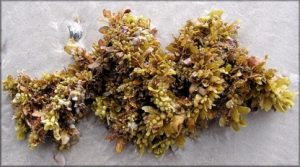
Sargassum: Edible but not the best of tastes.
This time of year it is not unusual for our beaches to be deep in aging seaweed at the high-tide mark. It’s usually almost all one species, Sargassum edible but not the tastiest of sea vegetables. It is true that nearly all seaweeds are edible if harvested from clean water. When I lived in Japan an annual environmental demonstration was to develop photographic film from unaltered water taken from Tokyo Bay. Instead of taking a few minutes, the developing took several hours but the point was made: The bay water was polluted. Generally said there are only two non-edible seaweeds in North American waters.
The first is Desmarestia ligulata. It is laced with sulfuric acid but is used to make pickles. You can find it along the northwest coast of the United States. You’ll know it when you find it because it will burn your mouth. The other in North America is a Cyanobacteria which is found in the Caribbean and linked to ciguarera poisoning. It’s not really a seaweed but is a blue-green algae found in the warmer waters. It is why one should never eat older barracuda. I should add never eat blue-green algae from fresh water either nor fish from a fresh water pond with a lot of blue-green algae. They are not on the menu. As for other parts of the world, there might be some toxic red seaweeds in the South Seas.
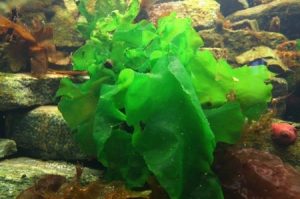
Sea Lettuce is perhaps the best tasting of our local seaweeds.
Since most seaweed is edible, and nutritious, why isn’t it consumed more often? Taste and texture. I’ve collected Sargassum here in Florida and prepared it many ways. Semi-drying and frying isn’t too bad but Bladderwrack is better, Sea Lettuce better still. The latter makes very nice salads. Not surprisingly most land animals including birds don’t like seaweed. However, it does make good mulch and fertilizer. So while one may not use it directly in the diet it can still help sustain you with uses in the garden. During Victorian times it was highly used in English agriculture. Here are some of my articles on seaweed: Bladderwrack, Caulpera, Codium, Gracilaria, Sargassum, Sea Lettuce, and Tape Seagrass.
This is issue 280.
If you would like to donate to Eat The Weeds please click here.


Super essay, Prof D, many thanks…here’s what worked like a charm for this mechanic’s itchy family&pals [including critters] :10 Best Homeopathic Medicines for Urticaria
By Dr. Vikas Sharma MD https://www.drhomeo.com/skin-problem/urticaria-and-homeopathic-treatment/ cheers
Hi,
another cracking newsletter -thank you!
There is at least one species of Desmarestia in New England – D. aculeta …not sure how widespread, but I have seen it in Maine.
tchau
BrianO
Thanks, I didn’t see any reference to it there.
My goodness, the silverthorn flowers smell wonderful right now! And the honey bees are having a blast! Thank you for teaching me so much about what is right under my nose!